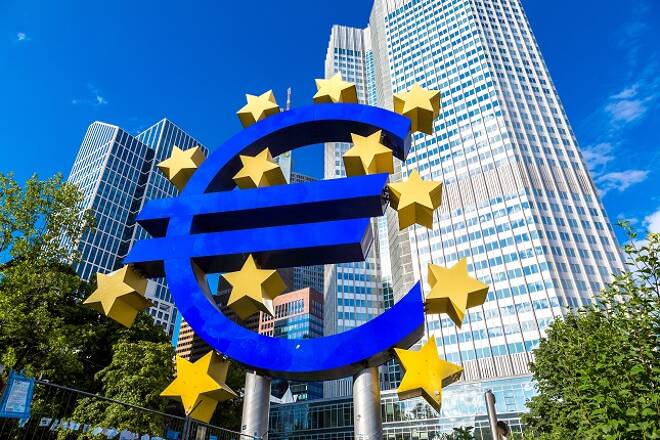Advertisement
Advertisement
EUR/USD Daily Technical Analysis for January 15, 2018
By:
Euro Breaks Out following Soft U.S. Inflation Data
The Euro shot higher on week dollar trade, following mixed inflation data which paved the way for a breakout. European yields continue to outpace the rise in U.S. treasuries which is driving the forward curve in favor of the Euro. Retail sales in the U.S. was slightly softer than expected but revision to prior months likely boosted growth.
Technicals
The EUR/USD surged higher breaking through resistance near the 1.2092, which is now seen as short-term support. Additional support on the currency pair is seen near the 10-day moving average at 1.2023. Momentum has turned positive as the MACD (moving average convergence divergence) index generated a crossover buy signal. This occurs as the MACD line (the 12-day moving average minus the 26-day moving average) crosses above the MACD signal line (the 9-day moving average of the MACD line). The RSU surged higher in tandem with price action reflecting accelerating positive momentum. Resistance on the RSI is seen near the 70 level. A break of this would be the confirmation of the breakout.
U.S. Retail Sales Were Strong
U.S. December retail sales increased 0.4% for the headline and ex-autos. The 0.8% jump in November sales was revised up to 0.9%, while October was boosted to 0.7% from 0.5%. The ex-auto index was revised higher too, to 1.3% versus 1.0% previously, with October now at 0.5% from 0.4%. Excluding autos, gas, and building materials, sales posted a 0.4% gain after a 1.2% prior increase. Vehicle sales rebounded 0.2% after dropping 1.0% in November. Gas station sales were little changed versus 3.0%. Sporting goods declined 1.6%, while miscellaneous sales were down 2.9%. Non-store retailers rose 1.2% from 4.2%. Real average hourly earnings rose 0.4% after a 0.2% November gain.
CPI Was Mixed
U.S. CPI edged up 0.1% in December, with the core up 0.3%. Prior data are not revised, leaving the November headline rising 0.4% and the ex-food and energy component up 0.1%. The 12-month rate slowed to 2.1% year over year versus 2.2% year over year, but the core accelerated a bit to 1.8% year over year versus 1.7% year over year. Energy prices declined 1.2% versus the 3.9% bounce. Transportation costs dipped 0.2% from 1.9%. Services prices increased 0.3% from 0.2%. Housing costs, including owners’ equivalent rent, were up 0.3%. Foods/beverage prices were up 0.1% after an unchanged November print. Apparel remained soft and slid 0.5% after falling 1.3% previously and is now down for four straight months. Tobacco dropped 0.6% from 0.2%. Commodities prices were 0.1% lower versus the prior 0.7% gain.
The Feds Kaplan Increased His GDP Forecast
Dallas Fed’s Kaplan said that he marked up his GDP forecast by 0.2% due to tax reform and projects growth in the 2.5% to 2.75% region for this year. His base case for interest rates is still for 3, and not less. Acting sooner rather than later will prevent the Fed from having to play catch-up, which in turn could lead to a recession. He could see the unemployment rate drop under 4%, but worries that could be an overshoot and would be a possible danger sign for the economy. He expects a big jump in oil supply out of the U.S., possibly in the 10.25 million barrels a year.
Breakthrough in German coalition talks.
Chancellor Merkel managed to successfully negotiate exploratory talks with the Social Democrats and SPD head Schulz is now backing formal coalition negotiations, although this is still subject to approval by party members, which now seem the last remaining hurdle to a rerun of the grand coalition. Markets are celebrating the deal already and while this is clearly not a love match, but a marriage of convenience, it is hoped that it will finally get things moving again, especially with regard to reforms in Germany and at EU level.
French and Spanish HICP revised down with final readings
The French number was revised down to 1.2% year over year from 1.3 year over year, the Spanish reading also to 1.2% year over year from 1.3% year over year and the combined revisions suggest the risk of a similar change in the final overall Eurozone reading, due next week. Still, the dip in headline rates at the end of last year was mainly driven by base effects and with oil prices having picked up since then, even a downward revision to the Eurozone HICP rate won’t prevent the ECB from starting to tweak its forward guidance.
About the Author
David Beckerauthor
David Becker focuses his attention on various consulting and portfolio management activities at Fortuity LLC, where he currently provides oversight for a multimillion-dollar portfolio consisting of commodities, debt, equities, real estate, and more.
Did you find this article useful?
Latest news and analysis
Advertisement
